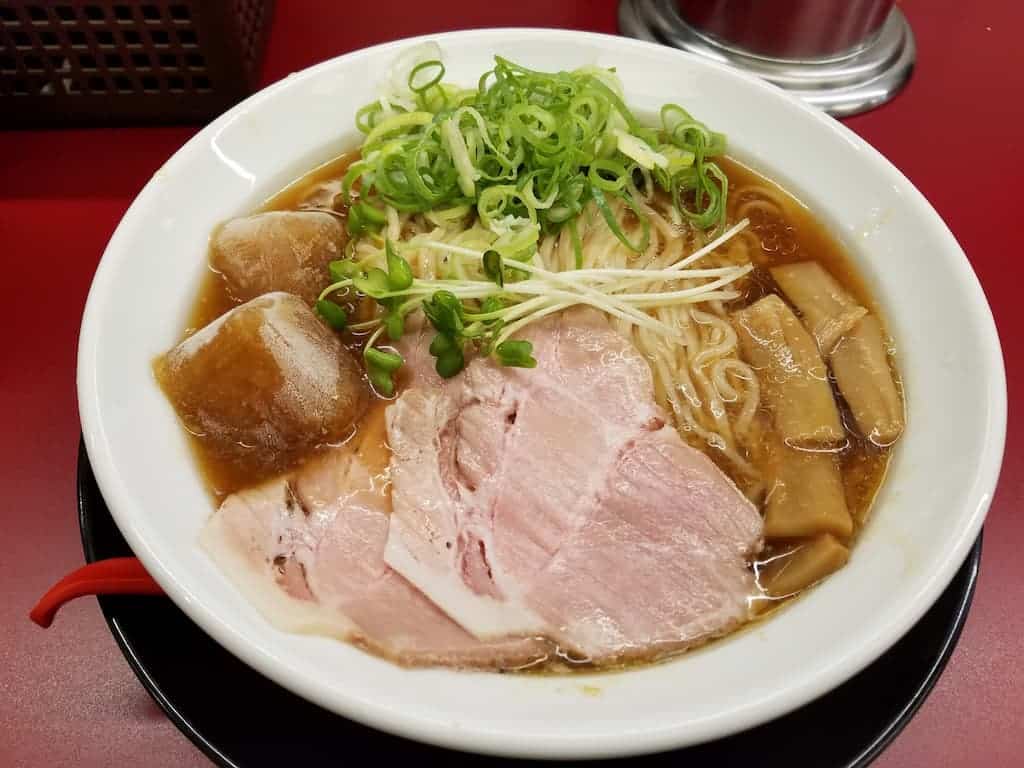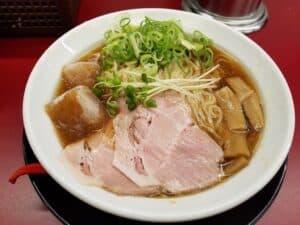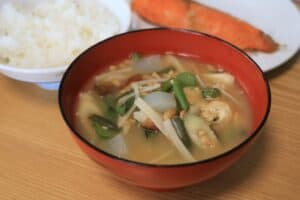Yamagata Prefecture is well-known for its beautiful landscapes, like the stunning Yamadera temple and Mount Zao. It’s also famous for its relaxing hot springs (or onsen). When it comes to food, Yamagata is popular for its tasty fruits, especially cherries. But that’s not all – the region has a variety of delicious dishes to offer, including a unique one called Tama Konnyaku. In this article, we’ll focus on learning all about this Konnyaku.
What is Tama Konnyaku?
Tama Konnyaku is a variety of konnyaku that is made by rolling and boiling without the use of molds or shaping tools. It comes in different types, including white and black konnyaku, as well as colorful variations that incorporate ingredients like red pepper, seaweed, and sesame. Adding Tama Konnyaku to dishes such as simmered dishes or oden can create a vibrant accent. However, in Yamagata, the locals’ favorite is the soy sauce-flavored Tama Konnyaku, known for its savory taste.
To prepare Tama Konnyaku, chefs form the konnyaku paste into small balls and boil them in a flavorful soy sauce broth. The konnyaku absorbs the savory soy sauce, infusing it with a rich and appetizing taste. The result is a delightful combination of softness and chewiness, with a hint of sweetness from the soy sauce. You can enjoy Tama Konnyaku on skewers, which making it a convenient and enjoyable snack at festivals, events, and tourist spots as the skewered Tama Konnyaku pieces are visually appealing and easy to handle.
About Konnyaku
Konnyaku has its origins in the Indochinese Peninsula. It is a type of processed food made from the tuber of a plant called the “konnyaku potato” or “konnyaku ball,” which belongs to the Araceae family. The konnyaku potato is originally from the Indochinese Peninsula and is nicknamed “elephant’s foot” because of its shape. Even today, there are many different types of konnyaku potatoes that grow naturally in Southeast Asia, with around 130 known species. These varieties are different from Japanese konnyaku potatoes in terms of their characteristics and do not contain konnyaku glucomannan, a dietary fiber. This means they do not solidify when processed and cannot be used to make konnyaku.
Because of this, konnyaku is mainly cultivated for consumption in Japan and some parts of China, with Japan being the main country where it is widely enjoyed. Konnyaku was introduced to Japan around the 6th century, alongside the spread of Buddhism from China. However, the exact details of its introduction are not clear.
History

画像提供元 : やまがたの広報写真ライブラリー
Tama Konnyaku has become immensely popular in Yamagata and across Japan. But have you ever wondered how it all began? In this section, we will find out the history and origin of this amazing dish!
The origin
Tama Konnyaku has a rich history dating back to the early 20th century in Yamagata Prefecture, Japan. It originated from the konnyaku specialty store, “Sensaiyama Konnyaku,” established in 1926 at the foot of Mount Chitose. This store is credited with creating the beloved dish.
The iconic “Yamadera” temple, officially known as Hojusan Risshakuji Temple in Yamagata City, also played a significant role in Tama Konnyaku’s history. During the Heian period, the temple incorporated konnyaku into its vegetarian cuisine. The renowned monk Jikaku Daishi, also known as Ennin Osho, brought konnyaku from China and popularized its use in the temple’s meals. This led to the widespread consumption of konnyaku throughout the region.
Tama Konnyaku’s nowadays cultural impact
Today, Tama Konnyaku holds a special place in Yamagata’s food culture. It is cherished as a soul food, enjoyed by both locals and visitors. The dish consists of small, round konnyaku pieces skewered and served at various events, festivals, and tourist spots in Yamagata. Its popularity stems from its unique combination of flavors and textures.
With its long-standing history and enduring popularity, Tama Konnyaku continues to symbolize Yamagata’s culinary heritage. It delights those who have the opportunity to experience its deliciousness, making it a treasured treat for all.
Tama Konnyaku FAQ
- How can I find Tama Konnyaku?
You can normally find it at festivals, tourist sites, cherry blossom viewing events, and various celebrations as it is a convenient and portable snack, making it a popular choice for fast food lovers.
- When is the best time to enjoy Tama Konnyaku?
While Tama Konnyaku can be enjoyed throughout the year, many people find it particularly delicious during the colder seasons. The warmth of the dish adds to its comforting appeal, making it a perfect treat during chilly weather.
How to make Tama Konnyaku at home?
Instructions to make Konnyaku (general method)
Ingredients
| Ingredients |
| Konnyaku powder (obtained from dried and processed konnyaku potatoes) |
| Water |
| Slaked lime (for making lime water) |
Methods
Heat water to a temperature of 50-70 degrees Celsius.
Gradually add konnyaku powder to the warm water while stirring continuously.
Mix well until the konnyaku powder is thoroughly combined with the water.
Set the mixture aside and let it sit for a while.
Dissolve slaked lime in warm water to create lime water.
Add the lime water to the konnyaku mixture from step 1.
Mix the ingredients quickly and vigorously, ensuring they are evenly combined.
Knead the mixture to achieve a uniform consistency.
Pour the konnyaku mixture into a rectangular mold.
Allow the mixture to sit undisturbed for approximately 30 minutes to 1 hour.
During this time, the konnyaku will start to set and firm up.
Fill a pot with plenty of water. Bring the water to a boil.
Carefully place the konnyaku block into the boiling water. Boil the konnyaku for 30 minutes to 1 hour to remove any bitterness.
Remove the cooked konnyaku from the boiling water.
Rinse it with fresh water to cool it down.
Place the konnyaku in a container filled with water. Change the water occasionally, allowing the konnyaku to soak for half a day to remove any remaining bitterness.
Recipe for Tama Konnyaku
Ingredients
| Ingredients | Amount |
| Tama Konnyaku | 20 pieces |
| Soy sauce | 2 tbsp |
| Dried squid | As needed |
| Prepared mustard | As needed |
| Skewers | 4 |
Instructions
In a pot, place the Tama Konnyaku and give it a gentle stir-fry. This step helps enhance the texture and flavor.
Pour 3 tablespoons of soy sauce into the pot with the stir-fried the Konnyaku.
Add torn pieces of dried squid to the mixture. Continue stir-frying to combine the flavors and coat the Tama Konnyaku with the savory soy sauce.
Take the skewers and carefully thread the Konnyaku onto each one. Make sure to distribute them evenly among the skewers.
If desired, you can apply a desired amount of prepared mustard to the skewered Tama Konnyaku. This adds a spicy kick to the dish. Once ready, you can enjoy it now as a delicious snack or appetizer! Itadakimasu!
Where to enjoy Tama Konnyaku?
Tanno konnyaku (丹野こんにゃく)

Tanno Konnyaku is a famous specialty from Yamagata, loved for its tama konnyaku. It has gained attention in the media, along with other konnyaku treats like sashimi konnyaku and tapi konnaku. These delicious konnyaku sweets not only taste great but also offer health benefits for your body. Let’s experience the unique flavors of Tanno Konnyaku and enjoy their exceptional konnyaku creations!
Chitoseyama (千歳山 こんにゃく店)

Chitoseyama Konnyaku, a historic and renowned restaurant in Yamagata, is a must-visit destination for konnyaku lovers. Their specialty, tama konnyaku, is just one of the delightful options they offer. Priced at an affordable 660 yen, their Kon Teishoku set meal includes flavorful dishes like beef and shredded konnyaku stew, sashimi-style konnyaku, pickles, miso soup with wheat gluten and shredded konnyaku, and rice. With their dedication to quality and delicious konnyaku creations, it’s a place you won’t want to miss while visit Yamagata.
Takeaway
Tama Konnyaku, a traditional dish in Yamagata’s culinary culture, is a must-try for those seeking authentic local flavors. This unique delicacy features large konnyaku pieces soaked in a flavorful broth, resulting in a satisfying and delicious taste. To experience the essence of Yamagata’s cuisine, we recommend trying your hand at making it at home. While recipes are readily available, the experience of exploring and experimenting with flavors can be rewarding. Alternatively, for those seeking a convenient option, we also recommend visiting local restaurants in Yamagata that specialize in traditional cuisine, where Tama Konnyaku is likely to be served as part of their menu.
If you are interested in Yamagata cuisine, click here to find out or see below!
















Comments